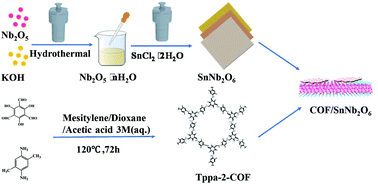Fabrication of 2D/2D COF/SnNb2O6 nanosheets and their enhanced solar hydrogen production†
Abstract
Accelerating light-induced carrier transfer and improving charge utilization are essential for enhancing the efficiency of solar hydrogen production. In this work, for the first time, 2D/2D covalent organic-framework (COF)/SnNb2O6 nanosheets were fabricated by a hydrothermal process. By adjusting the content of TpPa-2-COF, it was used to optimize the performance of solar hydrogen production. The optimal TpPa-2-COF/SnNb2O6 nanosheets show a hydrogen production rate of 7.66 μmol·h−1, which is 5.8-fold and 3.5-fold that of pristine SnNb2O6 and TpPa-2-COF, respectively. The significant improvement in the photocatalytic performance can be attributed to the formation of a 2D/2D heterojunction nanosheet with a good energy band position between TpPa-2-COF and SnNb2O6, which can efficaciously inhibit the restructuring of charge carriers. Through photoelectrochemical analysis, it is further proved that the interface interaction between TpPa-2-COF and SnNb2O6 can lead to effective charge separation. Moreover, the cycling experiments reveal that the as-prepared photocatalyst has excellent stability and recycling performance. This study shows that the smart integration of organic (COF) and inorganic materials into a heterojunction with a 2D/2D structure is an available tactic for the fabrication of efficient photocatalysts.

- This article is part of the themed collection: 2021 Inorganic Chemistry Frontiers HOT articles


 Please wait while we load your content...
Please wait while we load your content...